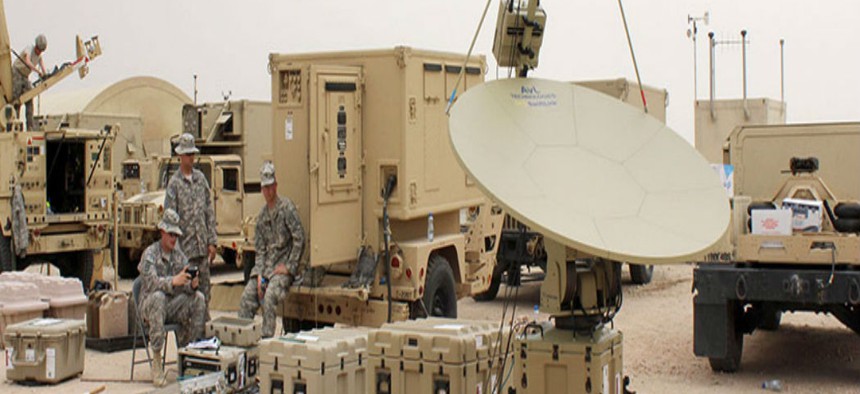OPED: can WIN-T evolve?
An network executive suggests adding network management tools to WIN-T
By Joe Kim - senior vice president and global CTO for Solar Winds
As military action becomes more dispersed, the Department of Defense (DOD) is expanding the concept of the wireless warfighter. A great example is the United States Army’s Warfighter Information Network-Tactical (WIN-T), which “delivers an extensive tailorable suite of integrated tactical network communication and network/cyber management capabilities to support today’s complex Joint, Coalition, and Civil missions worldwide.”
But as mobile technology continues to play a mission-critical role in national defense, the DOD must take steps to ensure that communications between commanders and armed forces remain clear and secure. It must implement strategies to monitor all aspects of its mobile networks for reliability and security.
Can You Hear Me?
Nobody wants a “can you hear me” situation when lives are at stake. Unfortunately, for many mobile military operations, reliable communication has become increasingly complex.
Today, there are several main issues that armed forces routinely encounter when setting up mobile communications and tactical operations centers (TOCs). Data and communications traffic can create bandwidth issues, resulting in the loss of critical messages. Additionally, communication at the edge of the network—also known as “last mile” communication—continues to be where the most support is needed. Two devices with the same IP addresses can pose conflicts that prohibit either device from being able to communicate.
It’s not just verbal communications that can be compromised; access to mission-critical data can also be problematic. Though the size and sophistication of the equipment will vary based on the mission, each TOC includes physical and virtual servers to host applications, storage systems, applications, and underpinning networks. Faulty communications networks can make it difficult for forces to access and share important resources and information, which could impact their missions.
Consistent and effective battlefield communications
The importance of automated network management and monitoring in this type of environment cannot be overstated, since it can be the key to maintaining consistent and effective battlefield communications. Military forces can easily identify potential problem areas in their mobile communications systems so that forces maintain constant and secure contact with each other and central command. Continuous network monitoring can also help proactively prevent issues—from possible cyberintrusions to bandwidth anomalies and beyond—before they become real problems.
There are several ways that managers can use network monitoring to improve warfighter communications. Bandwidth usage can be closely monitored to discern and identify network bottlenecks that could impact soldier-to-soldier and unit-to-unit communications, and provide network engineers with the information they need to alleviate the congestion. Network traffic types, patterns, and protocols can be closely analyzed to identify the impact that each of these components is having on the network. All of these reports can provide valuable information that can be used to reduce latency and jitters and improve overall quality of communications.
Managers can also use monitoring to ensure that their servers, storage systems, and applications remain functional and accessible to mobile forces. Server utilization, virtual machine performance and availability, storage capacity, and the status of applications can all be closely analyzed. Problems that occur within any of these areas can be isolated and addressed in a timely manner, ensuring the needed availability.
Further, engineers can receive actionable alert information that can be used to avert potential problems. Systems can be set to send out proactive alerts that derive information from trends and communications thresholds to warn managers of impending trouble, so they can address these threats before they occur. Additionally, reactive alerts pertaining to a system down or anomaly detections can be used to quickly identify the cause of everything, from mere communication network hiccups to more worrisome matters, such as potential cyberintrusions, hacks, or vulnerabilities. Managers can use these alerts to rapidly address these problems—a major benefit for military forces that may find themselves in remote areas with little time for remediation.
As for the problem of duplicate IP addresses, managers should implement IP address management solutions that allow them to automate the assignment of IP addresses. This practice eliminates the potential for a manager to inadvertently assign an address that is already in use—and, as a result, eliminate that particular mobile communication problem. It can also save a lot of time that would otherwise be spent looking for an open address.
Reliable tactical communications networks
Time, of course, is of the essence, particularly in battlefield operations. Mobile forces cannot afford to stop and take hours—perhaps days—to figure out why they’re not able to communicate with one another. As mobile communications become increasingly mission-critical, it’s imperative that the DOD and its agencies implement top-flight network management and monitoring procedures to ensure their tactical communications networks remain reliable and effective.
Joe Kim is senior vice president and global CTO for Solar Winds, a company that creates and markets network management software.





